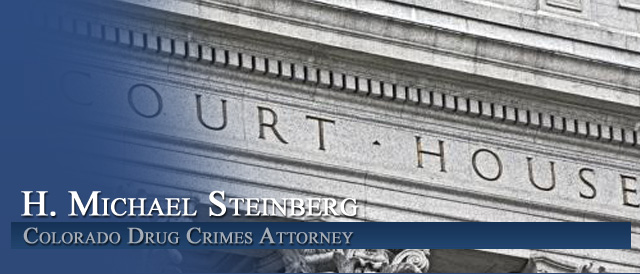




Colorado Criminal Law – Challenging the Drug Dog Sniff Search As Evidence
* My research ( from the NACDL*) demonstrates that Dog Sniff Search evidence should be challenged at every stage of the Colorado criminal trial proceeding. H. Michael Steinberg Colorado Criminal Lawyer
In Colorado Drug Dog Sniffs are becoming more and more common. While we all love dogs – this technique is far from infallible. The “alerting” dog “evidence” is very often the basis for a warrantless search of an automobile stopped on our streets and highways. Followed by a search warrant based upon the dog sniff evidence of a home belonging to the auto owner for example – and then felony drug charges. Colorado Criminal Defense Lawyers are attacking the “science” and execution of these drug dog searches here in Colorado – and winning.
The infallible dog, however, is a creature of legal fiction. ….. sniffing averages of drug dogs, their supposed infallibility is inconsistent by judicial opinions describing well-trained animals sniffing and alerting with less than perfect accuracy, whether owing to error by their handlers, the limitations of the dogs themselves, or even the pervasive contamination of currency by cocaine. .
Indeed, a study cited by Illinois in this case for the proposition that dog sniffs are “generally reliable” shows that dogs in artificial testing situations return false positives anywhere from 12.5 to 60 percent of the time, depending on the length of the search. . . . In practical terms, the evidence is clear that the dog that alerts hundreds of times will be wrong dozens of times.
Positive canine alerts are treated as virtually — if not completely — per se probable cause in virtually every circuit, at least if the canine is shown to be “trained” and “reliable”.
While those words appear with monotonous and unthinking regularity in judicial opinions relating to dog sniffs, handed down from opinion to opinion over the years, courts have, with a relative paucity of exceptions, demonstrated only an, at best, incomplete understanding of what these concepts actually mean in the real world and an entrenched disinclination to look much beyond the facts that the dog’s handler testified to the occurrence of an alert and that the dog was trained and certified.
There are two primary deficiencies in this narrow focus
First, it largely, if not entirely, ignores the role of the dog’s handler, generally a law enforcement officer and typically a local police officer or sheriff.
Second, and relatedly, it assumes that an “alert” is an alert because the handler said it was. Most courts have failed to consider — or even recognize — the role of the dog’s handler in the process.
The handler is not simply someone who holds the leash while the dog walks around and sniffs. Instead, the dog and handler function as an integral team. The dog is the sensor, and the handler is the trainer and interpreter. The handler’s performance in both roles is inseparably intertwined with the dog’s overall reliability rate. . . . And since the net result is the product of the interaction between two living beings, both roles of the handler are highly subjective.
Thus, the proper focus of the reliability inquiry is not simply upon the training and certification of the dog,10 but on the training and reliability of the dog/handler team.
Role Of The Drug Dog Handler
Dogs can be trained to distinguish various odors with some degree of accuracy, but they are far from infallible, and their responses are often only as reliable as the interpretations placed upon them by their handlers In fact, one commentator has reported that on most occasions on which no drugs are found as the result of a search based on a canine alert, the fault is not that of the dog but rather that of the handler in misinterpreting the dog’s behavior.
While a dog can be initially trained in a few weeks, training the human handler requires more time and effort. In some circuits, an affidavit in support of an application for a search warrant based in whole or in part upon a positive canine alert need do no more to establish the dog’s reliability than to state that the dog is “trained” and/or “certified.” This is, however, only half the equation. The focus must be redirected to the reliability and integrity of the dog/handler team. The amount of training the handler has had and the length of time the handler and dog have worked together are important factors, and the reported cases indicate that handler training runs the gamut from two weeks to hundreds of hours.
The amount of training and experience which the handler has had with the dog is a critical element, as, contrary to the way in which courts have tended to view the process, the dog does not announce to the handler that, if he searches, he will find drugs in a particular location. Rather, each dog behaves in a particular manner, which the handler then “interprets” as an “alert,” indicating the presence of drugs. An alert is not the objective proof as which it has generally been regarded by the courts; instead, it has a large — and sometime very large — subjective component. Some courts have expressed an appreciation of the role which handler interpretation plays in the process, although, with rare exception, that appreciation has not led to any less deference to the handler’s testimony that the dog alerted. Repeated stress upon the subjective and interpretive aspects of the canine inspection, bolstered by expert testimony should dislodge the unshakable faith which courts have placed in the objective veracity of canine alerts.
The Drug Dog Alert
Another too-little examined aspect of alert-based searches is the question of just what is an “alert.” Dogs are trained to give a particular response when they smell certain illegal drugs and, during training, are rewarded when they correctly give that response in the presence of drug odor. In general, dogs are trained to alert “aggressively” or “passively,” responses which have very different physical manifestations. When the handler testifies that the dog alerted in something other than the manner in which it was trained to respond to the presence of drugs, there is cause to question whether the dog actually did alert, i.e., give the final response which it was trained to make when it was certain that the odor it had been trained to detect was present and, concomitantly, reason to decline to base a finding of probable cause to search on the alert alone.
As Dr. Daniel Craig, a noted expert in canine training and performance, who has on a number of occasions testified as a defense expert witness in dog-sniff cases, has explained:
Detector dog handlers have been known to say things like “I can read my dog,” “My dog knows it’s there,” “My dog’s behavior tells me it’s in there,” “I can read my dog’s behavioral change and I know the odor is there,” “I am the only one who can read my dog,” “I know what my dog is thinking,” “I know when he is in the scent cone,” et cetera. Are they just repeating what they were taught? If not, where do they get this notion? In initial training and subsequent training the only time they reward (reinforce) their dog is when the dog makes the definitive defined final response. Then and only then can the trainer verify that the dog has detected and responded to a specific target odor. The dog is rewarded for that response and no other.
The first thing one must do . . . is decide what specific response the dog must make in order to determine if it is responding correctly to a selected target odor. . . . The handler or trainer must be able to articulate that specific response to anyone not in the dog training profession. That specific response is the only response you reward with the selected primary reinforcement. . . .
If the dog does not make the defined final response sometime during a search, the target odor is either not present or the dog or handler made an error. Dogs do respond when no target odor is present. They also fail to respond when a target odor is present. The handler may assume any response other than the defined final response verifies the presence of the target odor. At this point the handler is guilty of interpretation, supposition, or speculation. The dog has the olfactory sensing system (nose) and the final decision as to the presence or absence of a target odor is up to the dog and not the handler. A well-trained detector dog will only respond to the target odor(s) it has been properly trained to detect. That dog will emit the defined final response it was trained to make to a target odor at a predetermined rate of accuracy.
Educated guesses based upon the handler’s knowledge of their dog’s training and past performance are nothing more than educated guesses when their dog fails to make the defined final response during a specific search.
Thus, it is not enough that the handler testifies at the suppression hearing that the dog “alerted,” and defense counsel should hesitate before stipulating that the dog alerted and should refrain from conceding that an “alert” is a reliable indicator of anything. Instead, the handler should be examined at the suppression hearing or, where permitted, in pre-hearing deposition, to elicit a precise description of the definitive final response which the dog was trained to give upon identifying the odor of narcotics. If the dog gave any other response, then it was not doing what it was trained to do, and there is sound reason to question whether an alert did in fact take place. There may be videotapes of the dog’s training exercises available to assist in this process, just as there may be a videotape of the stop during which the canine sniff was conducted, both of which may provide crucial evidence, at least if the “alert” appears on the videotape, which — unsurprisingly — it sometimes does not.
Unfortunately, and incredibly, most courts have blindly credited testimony from handlers of the “I know it when I see it” variety.
Courts Are Taking a Closer Look at the Science of Drug Sniff Dogs
A few courts have, however, wisely been skeptical of reliance upon canine behavior which differed from the dog’s trained final response and depended entirely upon the handler’s interpretation of equivocal behavior. In United States v. Heir, for example, the dog was trained to alert by scratching, but had not done so in this case.
Instead, the dog sniffed intently around certain areas of the car, which the handler testified constituted an alert, acknowledging, however, that such alert behavior was “subtle” and might only be recognized by himself or another person familiar with the dog’s tendencies. Defense experts testified that they saw nothing on the videotape of the stop to indicate that the dog had alerted. The court adopted the magistrate judge’s conclusion that an alert had not occurred, as well as the conclusion that even if the alert behavior described by the handler occurred, it was too subjective a standard to establish probable cause. Instead, the court ruled, an “objectively observable ‘indication’ by the dog of the presence of drugs” was required.
Then there is the problem of “cuing,” conduct of the handler during the dog sniff which, consciously or unconsciously, influences the reaction of the dog and may prompt an “alert” reaction from the dog in response to the handler’s cues rather than to the presence of drugs. One important aspect of handler training is the avoidance of such cues. While courts have recognized the potentially pernicious effects of cuing, the ability of defendants to establish that cuing occurred has proven elusive.
For example, in United States v. Trayer, the defendant’s expert testified that it is possible for the handler to compromise the dog’s supposedly infallible objectivity through voice or physical cues and further testified that this sniff — along a train corridor outside the sleeping compartments — did not satisfy the best standards, as the dog was able to observe that the handler went only as far down the corridor as the defendant’s compartment before returning to the dog and bringing the dog down the corridor.
The court found this testimony “quite troubling” in light of the reliance which courts place on canine alerts in probable cause determinations, but, typically, ultimately upheld the search, as the defendant’s expert was unwilling to say from the evidence that the handler actually cued the dog.
The court did, however, express itself “mindful that less than scrupulously neutral procedures, which create at least the possibility of unconscious ‘cuing’, may well jeopardize the reliability of dog sniffs.” In United States v. McLaughlin, the defense expert testified, in essence, that the handler used his hunch that drugs were present to induce the dog to alert. The court agreed that “using a dog search as a sham in finding drugs — essentially not allowing the dog to employ the skill for which he was trained — would significantly decrease the reliability of the search,” but, as might be expected, concluded that the record did not support the contention that the dog sniff was simply a ruse.
Lacking, the court said, was any evidence that the handler’s conduct had an improper effect on the dog. In contrast, in Heir, in which the dog had responded by sniffing intently but did not give its trained final response, the defendant’s experts testified that “the alert behavior described by [the handler] could easily be attributed to his ‘cuing’ of the animal, either intentionally or unintentionally, by changing the leash from one hand to the other, by stopping, by blocking the way, or by other actions.”
The court was unwilling to accept that an actual alert had occurred. Cases like this one are too rare. The Supreme Court should revisit this issue as soon as possible and restore the protections of the Fourth Amendment which have gone to the dogs.
Drug Dog Sniff Search Reliability
“Reliability” is generally regarded by the courts as the measure of how likely an alert by the dog in question is to be an accurate indicator of the presence of drugs (or of whatever the dog has been trained to detect). Dogs are not scientific machines. A number of courts have recognized — or at least paid lip service to — the concept that a particular dog/handler team may be insufficiently reliable to support a finding of probable cause. As one court has stated:
[T]he possibility of error exists and, in limited circumstances, the error may be of such magnitude that a canine alert is not sufficient to establish probable cause. For instance, it stretches the bounds of jurisprudential imagination to believe that a positive alert by an untrained dog or by a dog with an extensive history of false positive alerts could be relied upon to establish probable cause without raising Fourth Amendment concerns.In challenging the reliability of the dog/handler team, access to the dog’s training, certification, and field performance records is essential. Some courts have recognized the importance of discovery regarding the dog’s training, certification, and performance records, but others continue to regard exploration of the documentary record of the dog’s performance as largely a waste of time, holding that the government need only present the testimony of the handler and need not produce the underlying records. The more thoroughly courts can be persuaded to regard alerts by dogs which simply have been “trained” and “certified” as something less than automatic probable cause, the more likely courts will come to regard discovery requests for the historical records of the dog’s training and field performance as an essential component of the litigation of motions to suppress where probable cause for the search was predicated in whole or in part on a canine alert.
Access to the records of the dog’s performance in training and in the field is essential to challenging predictable handler testimony regarding the always “excellent reliability” of their dogs — as well as to convincing courts that handler testimony alone should not be considered sufficient to establish the reliability of the dog. For example, handlers will sometimes report very high — even perfect — accuracy rates, even where drugs have not been found following the dog’s alert, based on the unprovable assumption that, if the dog alerted, it must mean that drugs had been present in the location to which the dog alerted.
Only with the dog’s training records can it potentially be determined how often this occurred. Unfortunately, courts have, by and large, been only too ready to accept the premise that “residual odor” provides a valid explanation for a false alert or to admit canine alert evidence as evidence that drugs were, at some time, present at the location to which the dog alerted.
The training and performance records are also the only way — assuming proper records have been kept (a major assumption) — to ascertain the dog’s actual reliability rate, which courts generally regard as the percentage of times the dog’s alerts have proven accurate. Such records are frequently the only means of establishing an accurate measure of just how often the dog has been right and how often it has been wrong.
The records may be just as important for what they do not show as for what they do show. For example, it is not enough that a dog has been trained and certified; the dog needs frequent practice to maintain its training, and the keeping of careful records is a crucial part of this process.
As one court has explained:
[The training and certification academy’s] manual instructed [the handler] to keep proper records of [the dog’s] activities and periodically field train [the dog] to ensure [the dog’s] continued reliability. [The academy’s] continued assurance of [the dog’s] accuracy depended on [the handler] following these instructions. Over time, if not properly monitored, a dog may fall out of its trained behavior and begin responding to a handler’s cues rather than to actual detection of a narcotic odor. A drug dog will lose its effectiveness in the field and may revert to old, bad habits if not continually trained. Accurate record keeping is essential to ensure the dog’s reliability until the dog is re certified.
Given the fact that in many circuits, an affidavit seeking a search warrant based on a canine alert need say no more than that the dog was trained and/or certified, it is important to stress whenever possible, in cases involving searches with and without warrants, that the fact that the dog was trained and certified is no guarantee of continuing reliability. Perhaps, over time, courts will get the message, although why they have not done so yet is unfathomable in light of the manifest unsoundness of equating a handler’s testimony that his dog alerted with automatic probable cause.
A Look At Drug Dog Search Warrant Affidavits
So unquestioning is the faith of courts in the accuracy of the “trained” and “certified” dog that in some circuits, the affiant need say no more about the dog to support a finding of probable cause, not even a conclusory statement that the dog is reliable. In other circuits, it suffices that the affidavit merely says that the dog has proven reliable in the past. Such rulings are entirely inconsistent with the well-established proposition that the judicial officer is to make an independent assessment of the existence of probable cause before issuing a warrant and not simply ratify the conclusions of law enforcement officers.
Unless the judicial officer is provided with information regarding the dog’s performance during training and in the field, he or she cannot make the requisite independent assessment of the likelihood that drugs will be found in the location to which the dog alerted. Instead, the probable cause determination will remain solely in the hands of law enforcement officers, where it does not belong.
Even where data regarding the dog’s past performance is set forth in the affidavit, affiants frequently mention only the dogs’ successes. Such data, however, presents an incomplete, and potentially highly misleading, picture. For example, if the affidavit says that actual drugs (not residual odor) were found fifty times when the dog alerted, this would reflect a phenomenal success rate if it had alerted a total of fifty times. The case would be quite otherwise however, if the dog had alerted a hundred times.
If the information regarding the dog set forth in the affidavit is inaccurate or materially misleading, or if material information regarding the dog’s reliability was omitted from the affidavit, then a challenge under Franks v. Delaware may be in order. It appears to be generally accepted that Franks applies — at least in theory — in the context of canine alert averments. A Franks challenge will be entertained, however, only if sufficient support for it is demonstrated — another reason why access to the dog’s records is so important.
The dog trained to alert aggressively tries to contact the scent source (biting, scratching, penetrating, attempting to retrieve), while the dog that alerts passively does not try to contact the scent source but instead performs trained behavior (sitting, looking at the source, sniffing toward the source, looking at the handler).
*National Association of Criminal Defense Lawyers (NACDL) 1660 L St., NW, 12th Floor, Washington, DC 20036 (202) 872-8600 • Fax (202) 872-8690 • [email protected]
Other Articles of Interest:
- The Defense Of Colorado Drug Crimes Cases – Questions Your Colorado Drug Crimes Defense Lawyer Should Be Asking…
- Understanding Denver Colorado Drug Possession Defenses And Tactics | Denver Criminal Drug Crimes Lawyer -Steinberg
- Colorado Strip Searches In Drug Cases – The Law – Know Your Rights – Colorado Criminal Defense
- Colorado Search And Seizure Issues – Were Your Rights Violated By The Police? Questions Your Lawyer Should Be Asking You…
- A Denver Colorado Criminal Lawyer On: What You Should If The Police Are At Your Door With A Search Warrant












